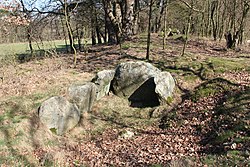Giant beds from Daudieck
| Giant beds from Daudieck Horneburg 2 - 4 | ||
|---|---|---|
|
Neolithic long bed A (Horneburg 2) near Daudieck. The rest of the burial chamber can be seen in the foreground. |
||
|
|
||
| Coordinates | 53 ° 29 '17.2 " N , 9 ° 32' 26.4" E | |
| place | Horneburg , Lower Saxony , Germany | |
| Emergence | 3500 to 2800 BC Chr. | |
| Sprockhoff no. | 661, 662, 663 | |
The giant beds of Daudieck lie between Gut Daudieck and the town of Issendorf , southwest of Horneburg and north of the river Aue , which is called Lühe from Horneburg , in the Stade district (in the Elbe-Weser triangle ) in Lower Saxony .
The oldest evidence of the settlement of the Horneburg Geestrand in the glacial valley of the Elbe can be viewed on an archaeological educational trail west of Gut Daudieck. According to the grave goods, the three giant beds date from around 3500 BC. In addition there is a stone box . Neolithic monuments are an expression of the culture and ideology of Neolithic societies. Their origin and function are considered to be the hallmarks of social development.
Megalithic bed A
Hünenbett A ( Sprockhoff No. 661 - also called Horneburg 2) is a hill 73 meters long and seven meters wide. Only a few stones of the edging have survived on the south-eastern long side. There is a destroyed chamber near the west end. In the middle is an incomplete chamber, the ceiling of which originally consisted of four stones (two end stones and two yokes ).
Giant bed B
Only two stones have survived from the border of the 48-meter-long and six-meter-wide Hünenbett B (Sprockhoff No. 662 - also Horneburg 3), about 100 meters to the south. In the middle there is a chamber remnant, of which three bearing stones have been preserved.
Giant bed C
The best preserved and in 1970 by Jürgen Müller dike examined is the passage grave in the barrow C (Sprockhoff No. 663 -. Also Horneburg 4), which is just east of barrow B. Almost nothing has been preserved from the edging of the 37 meter long megalithic bed. The unusually narrow access to the single chamber is on the south side. It consists of eight bearing stones and two end stones. Intermediate masonry was used in only four places . The western capstone is still on its three supporting stones (three-point support); the other two capstones are missing. The partially preserved pavement consisting of two layers (20 centimeters apart) indicates that it will be used again. In the western part there are two quarters behind one another , which divide the entire width of the chamber. A facility that is atypical for the region in terms of shape, location and material, which can be found in a slightly different form primarily in Mecklenburg-Western Pomerania and Sweden . A much more recent layer of charcoal indicates late activity in the complex. Only sparse finds were found in all of the giant beds.
To the south-west of the giant beds, in the depression of a hill, lies a stone box , of which only the two-meter-long capstone is visible. It is a cup stone that has a number of small bowls.
See also
literature
- Jürgen Deichmüller: The long beds from Daudieck In: Die Kunde NF 24, 1973, pp. 9–21.
- Daniel Nösler, Daudieck necropolis - a hiking trail through millennia. In: Daniel Nösler u. Andreas Schäfer (ed.), Lost property. Archeology between the Oste and the Elbe. MCE-Verlag, Drochtersen 2013, pp. 48–51.
- Ernst Sprockhoff : Atlas of the megalithic tombs of Germany. Part 3: Lower Saxony - Westphalia. Rudolf-Habelt Verlag, Bonn 1975, ISBN 3-7749-1326-9 , pp. 24-25.
Web links
Individual evidence
- ↑ J. Müller In: Varia neolithica VI 2009 p. 15





